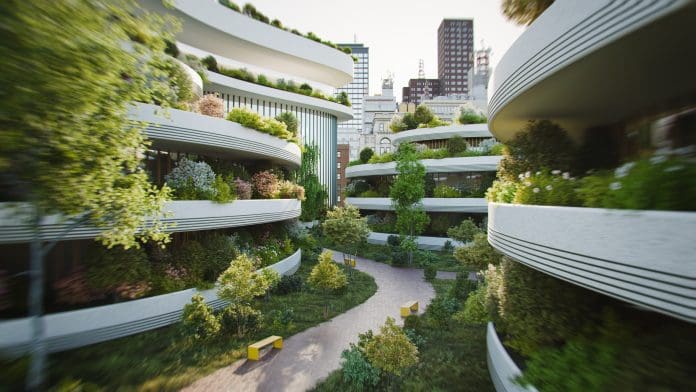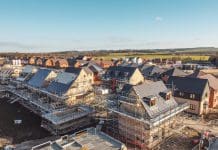Nature-inspired design is revolutionising civil engineering with sustainable, eco-friendly structures—discover how this innovation is transforming our built environment
Biogenic construction takes inspiration from nature, leading to eco-friendly designs. These designs incorporate elements like microbial techniques and biomimetic materials, creating sustainable structures that greatly reduce carbon footprints. Nature-inspired methods, such as green roofs and self-healing concrete, not only promote biodiversity but also improve energy efficiency and air quality. By observing nature’s efficiency and adaptability, engineering projects become more resilient and resource-efficient. Despite challenges such as traditional practices and cost concerns, the future holds exciting advancements in integrating the wisdom of natural systems into engineering.
Principles of nature-inspired design
When you explore the principles of nature-inspired design, you tap into billions of years of evolutionary wisdom that optimise resource use and environmental interactions. This bioinspired approach to engineering seeks to emulate the efficiency and adaptability of natural systems, which have evolved over 3.5 billion years.
Bio-inspired design focuses on creating products that maximise performance while minimising material usage. Nature demonstrates this through the hierarchical organisation of biological materials, which range from the molecular to the macroscale. This organisation showcases multifunctionality and efficiency, offering valuable lessons for construction practices.
When you explore biomimicry, you’ll find three main levels—organisms, behaviour, and ecosystems—that provide a wealth of inspiration across various fields. Each level offers unique insights that can be leveraged to promote innovation in engineering and design. Additionally, the five dimensions of biomimetic design—form, material, construction, process, and function—serve as a robust framework for developing solutions that draw from nature’s strategies.
Benefits of eco-friendly engineering
Biogenic construction is at the forefront of this eco-friendly engineering movement, offering a plethora of benefits that transform the way we perceive and build structures. By tapping into natural materials and processes, you can greatly reduce your project’s environmental footprint, lowering emissions and energy consumption.
Incorporating elements like green roofs and vertical gardens not only beautifies buildings but also enhances air quality and promotes biodiversity. They can cut urban heat by up to 50% and actively contribute to carbon sequestration, helping mitigate climate change. Imagine a building that not only shelters but also breathes and interacts with its ecosystem.
Moreover, advances in microbial construction techniques, such as self-healing concrete, are game-changers for resource efficiency. These innovations minimise material waste and extend the lifespan of structures, ensuring that your projects are more sustainable over time.
The benefits of eco-friendly engineering also extend to human health and well-being. By creating environments that harmonise with nature, you foster spaces where occupants can thrive. Natural elements in design reduce stress and enhance comfort, making buildings more than just functional.
Additionally, biogenic construction promotes collaboration across disciplines. By bridging engineering, biology, and architecture, you’re part of a movement that aligns construction practices with long-term sustainability goals.
Innovations in material efficiency
As the push for sustainable building practices gains momentum, innovations in material efficiency are taking center stage. Take, for example, biomimetic materials like spider silk. By studying the tensile strength of spider silk, which rivals that of steel, engineers can develop lightweight yet robust materials. This not only reduces the amount of raw material needed but also enhances structural performance.
Another exciting development is microbial construction techniques such as biocement. This approach achieves compressive strengths comparable to traditional concrete but with considerably lower energy consumption and carbon emissions during production.
Additionally, nature-inspired designs from ant colonies offer insights into geotechnical engineering. Ants build efficient tunnel systems using minimal resources, providing cues on how to optimise resource use and improve structural integrity in construction projects. Their natural ventilation systems inspire architectural designs that can reduce energy consumption by a staggering 30%.
Challenges in implementation
Despite the promising potential of biogenic construction, the industry’s shift toward these methods faces significant challenges. You might find that traditional civil engineering practices are quite conservative, often resisting innovative approaches in favour of tried-and-true techniques. This resistance can slow down the adoption of nature-inspired designs, even when they offer clear benefits in sustainability and efficiency.
One of the main implementation challenges is the limited availability of biogenic materials and technologies. Many construction professionals aren’t familiar with these alternatives, which can make it difficult to integrate them into existing projects. Without widespread knowledge and accessibility, the full potential of biogenic construction remains untapped.
Regulatory frameworks and building codes also present hurdles. In many regions, these codes haven’t evolved to accommodate biogenic principles, creating barriers for new projects that wish to employ these innovative methods. As a result, maneuvering through these regulations can be a formidable task for those looking to incorporate biogenic solutions.
Interdisciplinary collaboration is another area where you might encounter difficulties. Successfully implementing biogenic construction often requires engineers, biologists, and architects to work together. Effective communication and shared knowledge across these fields are vital, but achieving this synergy can be challenging.
Finally, financial constraints and perceived higher upfront costs can deter stakeholders. Many are hesitant to invest in biogenic construction due to concerns about initial expenses, even though these methods offer long-term benefits. Convincing stakeholders to look beyond short-term costs and focus on sustainable gains is essential for overcoming these implementation challenges.
Future trends in civil engineering
Although implementing biogenic construction faces hurdles, the future of civil engineering looks bright as it embraces sustainability and innovation.
- Educational advancements: Future engineers will be well-equipped with bioinspired design methodologies, as civil engineering curricula increasingly include these concepts. This prepares you to innovate using natural processes and materials.
- Interdisciplinary collaboration: Engineers, biologists, and architects will work together more frequently. This collaboration enhances the feasibility and effectiveness of biogenic construction techniques, leading to more resilient and sustainable structures.
- Technological innovations: Advances in computational algorithms will allow for precise modelling of biological systems. You’ll see these innovations drive new design and material development, making structures more efficient and eco-friendly.














